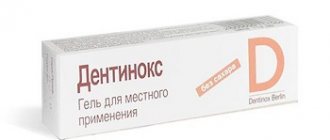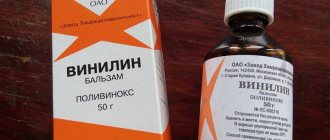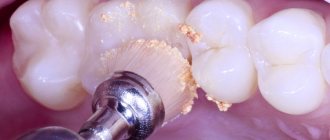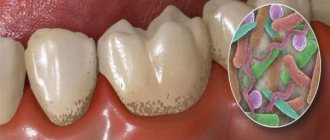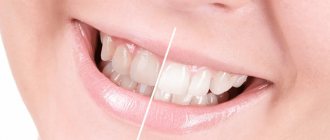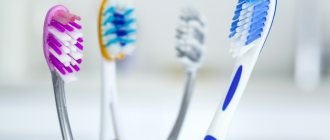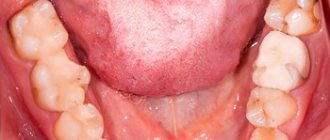1195
Devitalization in dentistry is the destruction (killing) of the pulp for the purpose of its subsequent painless removal.
The procedure is carried out using devitalization drugs that kill the nerve bundle of the pulp and cause the death of its tissue.
One of the drugs popular among dentists is Kaustinerv, which will be discussed further.
Indications and contraindications
Killing the pulp using devitalization pastes is used in cases where it is impossible to use injection or application methods of local anesthesia.
The following reasons may lead to such situations:
- hypersensitivity of the patient's body to anesthetics, in particular to lidocaine;
- insurmountable fear of the patient (usually children) to injections;
- the presence of severe systemic diseases;
- failures (insufficient pain relief) of the injection or application method.
General information
Devitalization in the dental field is the process of killing the pulp for its further removal without pain. The process is possible with the use of devitalization agents, which can kill the nerve processes of the pulp and cause the death of its tissues.
What does a tooth look like?
The surface of a healthy tooth is covered with white enamel, underneath is dentin. The inside of the tooth is made up of pulp with small blood vessels and nerves.
The number of large nerves directly depends on the structure of the root and the number of its processes. And the bundle of nerves in the pulp is formed by compact nerve fibers.
When the crown is destroyed down to the pulp, increased pain begins to appear.
Why is removal necessary?
It is possible to exclude nerve removal if therapy begins at the primary stage of dentin destruction. Pulpitis, which has passed into the periodontium, is a symbol of the transformation of the disease. Then the elimination of the nerve or pulp cannot be avoided.
Surgery is necessary when a tooth is deformed. Defragmentation is possible from caries or physical trauma.
Symptoms of inevitable depulpation:
- aching soreness that occurs for no reason and persists for a long time. Has no tendency to complacency.
- episodic pain. The reasons are a change in the level of humidity in the room, from cold or hot products, from eating a large amount of sweets. After eliminating the source of irritation, pain is still present.
- an unnatural dental arrangement determined from an anatomical point of view.
- inflammatory process in the pulp or the onset of periodontitis.
- mechanical trauma with damage to dentin.
Instructions for use
Devitalization is performed in the following sequence.
- A carious cavity is developed , and a recess is made at its bottom to place the paste at a minimum distance from the pulp.
- A small ball (about the size of a pinhead) is made from the paste and carefully, without pressure, placed into the hole.
- A temporary filling is placed on the tooth , and the patient is sent home. A repeat visit is scheduled after a few days, depending on the duration of action of the devitalization paste.
- At the next visit, the temporary filling is opened and removed along with the devitalizing drug. Under the influence of arsenic or paraformaldehyde, the pulp becomes fibrous and can be removed easily and painlessly.
Sometimes, due to severe pain, it is not possible to get close to the pulp. In this case, devitalization is performed in two steps.
After the first application of the medicine, due to a decrease in the sensitivity of dentin, it becomes possible to get closer to the pulp.
Next, endodontic treatment of the tooth is carried out according to the standard scheme:
- Access to the coronal cavity is created using burs , the affected tooth tissue is excised and removed.
- The tooth cavity is opened and the contents of the pulp chamber are removed.
- Root canals are treated. Mechanical treatment is combined with medication using antiseptic, degreasing and hydrating drugs.
- Obturation (filling) of the root canals is carried out with cement or composite material.
- Finally, the crown part of the tooth is formed , which, if necessary, can be covered with an artificial filling.
Drastic ways to kill the dental nerve
If rinses and lotions do not help, and the tooth does not allow you to live in peace, you can try to solve the problem in a more drastic way. There are quite a few myths about how to kill a nerve in a tooth at home. One of the most ridiculous is the use of gunpowder. First of all, where would he get a house from? And secondly, such amateur activity is fraught with sad consequences for the body. However, like putting arsenic in the hole of a tooth. This is a powerful poison that, even in tiny doses, can deprive a person of not only his nerve, but his life! It is important to understand that the pastes discussed above do not use arsenic itself in its pure form, but its salts in carefully adjusted proportions.
So how can you kill the nerve in a tooth if you can’t go to the dentist right now?
- Vinegar essence. Unlike gunpowder and arsenic, it is much easier to get. The manipulation is simple: moisten a small cotton swab with acid and place it in the hole of the tooth. You must first thoroughly disinfect your hands so as not to aggravate the situation by adding pathogenic microbes, and act carefully, as there is a high risk of burning your gums.
- Alcohol. If rinsing with alcohol tinctures does not help, you need to wet a piece of cotton wool with alcohol and place it at the epicenter of the pain, preferably directly into the carious hole.
- Zinc. Of course, it may not be at home in its pure form. But it is easy to obtain from ordinary printing ink. To do this, you can take any sheet of newspaper, but it is better if there are large black drawings on it, crumple it on a plate and burn it. Then, using a cotton swab moistened with your own saliva, quickly collect the ashes and place them in the tooth. The whole thing can be covered with another clean swab on top. Aldehydes and zinc contained in the ashes will kill the nerve. To prevent the procedure from being so painful, 15-20 minutes before, you can take a Ketanov tablet or another strong painkiller. The most effective medications for toothache are baralgin, novalgin, analgin, and pentalgin.
Whatever method of self-help you practice, the main thing to remember is that you still cannot do without the help of a dentist. Even if you managed to kill the nerve in the tooth at home, no later than two weeks later, you will still have to sit in the doctor’s chair so that he removes the dead tissue, cleans and seals the canals. Otherwise, a protracted inflammatory process cannot be avoided.
Sources used:
- Practical dentistry / I.K. Lutskaya. - M., 2000.
- Prevention of caries in the pits and fissures of teeth / T.V. Popruzhenko. - M.: MEDpress-inform, 2010.
- Practical therapeutic dentistry" (Nikolaev A.)
- Therapeutic dentistry, E. V. Borovsky et al., Moscow., 1998
- Dr. Mercola. Why Don't You Try This?: 97% of Terminal Cancer Patients Previously Had This Dental Procedure
Dosage and precautions
When using all devitalization pastes, the same dosage is used - a tiny ball of paste the size of a pinhead (about 1 mm in diameter). The maximum permissible dose is 10 mg.
Since these are highly toxic drugs, the following precautions must be observed:
- It is necessary to prevent accidental swallowing of the paste.
- For a temporary filling, use cement of a weak consistency so that it can be opened without excessive force, which could cause the release of paraformaldehyde or arsenic.
- The temporary filling must be absolutely airtight. If arsenic or paraform comes into contact with the mucous membrane of the gum or cheek, irritation and necrosis may occur. If a leak does occur, the affected area should be rinsed quickly with water.
- The paste should not be left in the tooth for more than 7 days.
- The medicine ball should be placed in the place prepared for it without strong pressure.
Important! Devitalization drugs contain substances that can give a positive reaction in a doping test.
Contraindications for devitalization are:
- allergy to the ingredients of the devitalizing paste (most often the culprit is lidocaine);
- age up to 30 months;
- glaucoma;
- anuria.
General presentation and purpose
Kaustinerv paste is produced by the French pharmaceutical company in three varieties:
- Forte. This product contains phenol and lidocaine and is used to remove pulp if it is necessary to use arsenic-free formulations.
- Arsenical . This type contains arsenic; the paste is used for devitalization if there are no contraindications for the content of this component.
- Rapid. This is an arsenic variety with menthol, ephedrine and lidocaine.
The paste has an analgesic effect, is used for rapid extirpation of tooth pulp and promotes an antiseptic effect.
Storage conditions
Kaustinerv devitalizing pastes can be stored for up to six months at a temperature not exceeding 25 °C. The material in opened cans retains its performance properties for a year, provided the lid is tightly closed.
Additional conditions for use and storage of pastes are contained in the instructions.
The purpose of using arsenic in dentistry and analogue products.
In this publication we will talk about what a pediatric dentist surgeon does.
Here https://www.vash-dentist.ru/hirurgiya/rezektsiya/effektivnost-tsistektomii-zuba.html read about the indications and contraindications for dental cystectomy.
Composition and properties
The composition includes the following components:
- Lidocaine – up to 37%.
- Arsenic (only in two varieties - Rapid and Arsenical).
- Paraformaldehyde – up to 46%.
- Phenol.
The presence of paraformaldehyde in the composition promotes the coagulation of albumin, and lidocaine serves as the main anesthetic component and acts as a local anesthesia.
The impact of the paste leads to softening of the pulp and increased fibrousness, due to which rapid removal occurs.
Let's find out together why the tooth hurts after nerve removal and cleaning, and what can be done.
Come here if you are interested in how to kill the dental nerve.
At this address https://zubovv.ru/hirurgiya/udalenie-nerva/kak-ispolzuyut-myishyak-v-stomatologii.html we’ll talk about modern arsenic substitutes in dentistry.
Analogues and prices
The following preparations can be used as a replacement for Caustinerf pastes:
- Depulpin. Contains paraformaldehyde. When used, side effects are possible in the form of pain, which gradually subside under the influence of the lidocaine contained in the paste. Release form – 3 g of paste placed in a syringe.
- Devital. Arsenic-free preparation containing 30 percent paraform.
The advantages of Devital include the absence of arsenic, the ability to be used for children, and the relatively short time for complete devitalization, usually 3-5 days. But sometimes canal cleaning and final filling can be done within 1-2 days. Available in 5 and 13 g in plastic and glass bottles. - Devit S. Contains paraformaldehyde, as well as auxiliary materials - lidocaine, creosote, paste former with filler. The average time of devitalization is 3-5 days.
Prices for pastes vary significantly, and depend primarily on the brand.
Approximate prices for devitalizing pastes are shown in the table.
| Trademark | Manufacturer | Active substance | Quantity, g | Price, rub |
| Kaustinerv Fort | Septodont (France) | Paraformaldehyde | 4,5 | From 4000 |
| Kaustinerv Rapide | Same | Arsenic oxide | 5,5 | From 2600 |
| Kaustinerv Arsenical | Same | Arsenic oxide | 6,5 | From 4000 |
| Depulpin | Voco (Germany) | Paraformaldehyde | 3 | From 3100 |
| Devital | TechnoDent (Russia) | Paraformaldehyde | 5 and 13 | From 200 |
| Devit S | VladMiVa (Russia) | Paraformaldehyde | 3 | From 120 |
Buy Ripart Forte synovial fluid prosthesis 15 mg/ml 3 ml No. 1 in pharmacies
product name
“Medicine for replacing synovial fluid RIPART®, volumes 1 ml, 2 ml, 3 ml, RIPART® Forte, volumes 1 ml, 2 ml, 3 ml and RIPART® Long, volumes 1 ml, 2 ml, 3 ml” (hereinafter referred to as text - Means for replacing synovial fluid).
Type of contact with the human body: constant contact with the internal environment of the body.
This product is sterile. For single use.
Conditions of use: in clinics, hospitals and other medical institutions by qualified medical personnel trained in the technique of injecting synovial fluid replacement agents.
Application area
The product is used for administration to replace synovial fluid in case of joint damage, to eliminate pain and improve joint mobility. The agent for replacing synovial fluid is used for osteoarthritis and other degenerative-dystrophic, traumatic and post-traumatic changes in the joints: knee, hip and other large joints, as well as as an aid in orthopedic surgery.
The medical device is used in traumatology, orthopedics, and sports medicine.
Product characteristics
The synovial fluid replacement product is a sterile, colorless and transparent viscous solution of highly purified sodium hyaluronate, obtained by biofermentation. The product contains sodium hyaluronate in a concentration of 10 mg/ml (RIPART® synovial fluid replacement agent), 15 mg/ml (RIPART® Forte synovial fluid replacement agent) and 20 mg/ml (RIPART® Long synovial fluid replacement agent), sodium dihydrogen phosphate, disodium hydrogen phosphate, sodium chloride 0.9% solution for infusion.
Sodium hyaluronate is the sodium salt of hyaluronic acid, a glycosaminoglycan formed by groups representing D-glucuronic acid and N-acetyl-D-glucosaminodisaccharide. It is widely present in the extracellular matrix in both animals and humans. The molecular weight of sodium hyaluronate used in the manufacture of the synovial fluid replacement agent must be at least 3 MDa.
Sodium hyaluronate belongs to a small group of substances that are the same for all living organisms. Sodium hyaluronate is a natural polysaccharide that is part of all tissues of the body, and sodium hyaluronate is found in especially high concentrations in synovial fluid and skin. The synovial fluid replacement agent consists of biosynthetically produced and purified sodium hyaluronate. Sodium hyaluronate in the body is a natural component of synovial fluid, which in joints serves as a lubricant for cartilage and ligaments, and is also an shock absorber. It is known that synovial fluid in affected joints has lower viscosity and elasticity than synovial fluid in healthy joints. Injecting sodium hyaluronate into a joint to restore viscosity and elasticity can reduce pain and restore joint mobility.
The composition of the synovial fluid replacement agent ensures the restoration of viscoelastic properties and the transition of the viscous properties of the solution into elastic (elastic) in the range of shear rates from 0.5 to 2.5 Hz, which corresponds to the range of movements from walking to running.
Main technical characteristics and materials used in manufacturing
Table 1. Main technical characteristics of the product
| Index | Values | |
| 1 | Chroma | Colorless |
| 2 | Transparency | Transparent |
| 3 | Overall length (pre-filled syringe with piston), mm (± 1%) | 117 (for a syringe with a volume of 1 ml) 135 (for a 2ml syringe) 153 (for a 3ml syringe) |
| 4 | Weight of the product in individual packaging (in a syringe), g (± 10%) | 12.0 (for a syringe with a volume of 1 ml) 13.1 (for a 2ml syringe) 14.2 (for a syringe with a volume of 3 ml) |
Table 2 - Materials used in the manufacture of the product
| Product part name | Material |
| Synovial fluid replacement agent | One milliliter contains: Sodium hyaluronate 10/15/20 mg Sodium dihydrogen phosphate 0.1 mg Disodium hydrogen phosphate 0.6 mg Sodium chloride, solution for infusion 0.9% – up to a volume of 1 ml |
| Syringe: | |
| Cylinder | Borosilicate glass Type 1 |
| Cap | Elastomer BDM-PS |
| Syringe rod | Elastomer BDM-PS |
| Piston seal | Elastomer BDM-PS |
| Finger rests | Elastomer BDM-PS |
| Package | |
| Individual packing | Paper, polymer film |
| Cardboard pack | Cardboard |
Information about the presence of a medicinal product, materials of animal and (or) human origin in a medical product
The synovial fluid replacement product contains the following drugs:
- sodium hyaluronate; - sodium chloride, solution for infusion 0.9%;
Materials of animal and (or) human origin are not contained in this medical product.
Sterility
The product is supplied sterile. Sterilization parameters: steam sterilization method in accordance with the requirements of GOST R ISO 17665-1.
Repeated sterilization of the product is prohibited. Reuse is prohibited.
Indications, contraindications, warnings, precautions, side effects
Indications for use:
— Osteoarthritis and other degenerative-dystrophic, traumatic and post-traumatic changes in joints: knee, hip and other joints. — As an aid in orthopedic surgery. — For use in patients who have increased physical activity and regularly load the damaged joint.
Contraindications:
— Do not use in patients suffering from hypersensitivity (allergy) to products containing sodium hyaluronate. — It is prohibited to inject the Synovial Fluid Replacement Agent into the joint of patients who have infectious or skin diseases in the area where the injection is intended.
Warnings:
To prepare the skin, it is prohibited to simultaneously use disinfectants containing quaternary ammonium salts, since sodium hyaluronate may form a precipitate in their presence.
Intravascular administration is prohibited due to the possibility of systemic adverse side effects. It is prohibited to use the product to replace synovial fluid during intraocular surgery.
Precautionary measures:
— The safety and effectiveness of injection of this product in parallel with other intra-articular injections have not been studied. — Efficacy has been established only if the minimum recommended course of treatment is followed. — The synovial fluid replacement agent should be used with caution in patients with signs of impaired venous or lymphatic drainage in the lower extremities. — For bilateral treatment, separate syringes should be used for each knee or hip joint. — Local anesthetics should not be used if the patient is known to be allergic or hypersensitive to local anesthetics. — X-ray-guided hip injections should not be performed using radiocontrast agents if the patient is known to be allergic or hypersensitive to radiocontrast agents. — STERILE CONTENTS. The pre-filled syringe is intended for single use. The contents of the syringe must be used immediately after the container is opened. Any unused amount of Synovial Fluid Replacement Agent should be discarded. — It is necessary to check the expiration date and the integrity of the individual packaging (syringe) before using the medical product. Do not use after the expiration date, or if the packaging is open or damaged.
Side effects:
The synovial fluid replacement agent is well tolerated. Possible side effects include short-term pain at the injection site, a feeling of heat, bruising, redness and/or swelling. As a rule, such reactions disappear without a trace within 2-3 days and do not in any way affect the effectiveness of treatment. Cases of allergic and anaphylactic reactions are rare. If precautions are not taken during intra-articular administration, septic arthritis may occur in very rare cases.
Risks of use:
The manufacturer has determined the risks for the patient associated with the occurrence of each type of hazardous factors and the occurrence of their consequences. The parameters for reducing risks when applying measures to prevent the occurrence of conditions for the manifestation of hazardous factors or the occurrence of their consequences are calculated.
It has been established that after the implementation of risk control measures, no new risks arise, and the overall residual risk is considered acceptable; The production risks do not change depending on the composition and type of packaging of a medical product.
Patient Information
- As with any invasive procedures performed on the joints, the patient is advised to avoid any physical exertion, as well as prolonged (lasting for more than 1 hour) activities associated with bearing weight loads (this applies, for example, to jogging and tennis) within 48 hours after intra-articular injection of the product. — The safety and effectiveness of use of the drug for replacing synovial fluid in women during pregnancy and lactation, as well as in children under 18 years of age, has not been established.
Recommendations for a medical specialist
The volume of synovial fluid replacement agent administered depends on the size of the joint. The physician is responsible for determining the applicable volume and must ensure that the joint is not overloaded.
A course of treatment with RIPART® synovial fluid replacement agent usually requires a cycle of procedures consisting of 3-5 injections (with an interval of 1 week).
A course of treatment with RIPART® Forte, a synovial fluid replacement agent, usually requires a cycle of procedures consisting of 1-3 injections (with an interval of 1 week).
A course of treatment with RIPART® Long, a synovial fluid replacement agent, usually requires a cycle of procedures consisting of 1-2 injections (with an interval of 1 week).
The amount of sodium hyaluronate injected into the joint during the procedure is determined according to tables 3, 4 and 5. The choice of dosage is at the discretion of the attending physician.
Table 3. For RIPART® Synovial Fluid Replacement Agent
| Syringe filling volume (10 mg/ml (1%)) | The amount of sodium hyaluronate in the syringe |
| 1 ml | 10 mg |
| 2 ml | 20 mg |
| 3 ml | 30 mg |
Table 4. For Synovial Fluid Replacement Agent RIPART® Forte
| Filling volume (15 mg/ml (1.5%)) | The amount of sodium hyaluronate in the syringe |
| 1 ml | 15 mg |
| 2 ml | 30 mg |
| 3 ml | 45 mg |
Table 5. For Synovial Fluid Replacement Agent RIPART® Long
| Filling volume (20 mg/ml (2%)) | The amount of sodium hyaluronate in the syringe |
| 1 ml | 20 mg |
| 2 ml | 40 mg |
| 3 ml | 60 mg |
If necessary, the course can be repeated.
The decision on the applicability of a repeated course is made by the attending physician.
Procedure for working with a medical device
1. The synovial fluid replacement agent is administered intra-articularly once. Subcutaneous administration of lidocaine or a similar local anesthetic may be recommended prior to administration of the synovial fluid replacement agent. 2. Do not use Synovial Fluid Replacement Product if the blister pack is opened or shows signs of damage. Do not use the product after the expiration date indicated on the packaging. 3. When preparing for use and during the actual use of a medical device, strict adherence to aseptic rules is required. 4. If necessary (if present), remove joint effusion before administering Synovial Fluid Replacement Agent. 5. It is necessary to remove the screw cap of the syringe and the cap of the needle tip in compliance with all the rules of asepsis. Introduction Means for replacing synovial fluid into the joint must be carried out using an appropriately sized needle (selected based on the size of the joint). The needle is not included in the product packaging.
Inject the required volume of synovial fluid replacement into each joint. If there is a doctor's order that involves injection into several joints, a separate syringe must be used for each joint.
The synovial fluid replacement product is a DISPOSABLE MEDICAL DEVICE (REPEATED USE IS PROHIBITED).
Conditions of use, storage and transportation
The medical device is used indoors at an ambient temperature of 2°C to 25°C.
Transportation must be carried out by all types of transport, in closed vehicles, in accordance with the rules for the carriage of goods in force for this type of transport.
The synovial fluid replacement agent must be transported in the manufacturer's packaging at a temperature of 2°C to 25°C and a relative humidity of 30 to 75% without moisture condensation.
The synovial fluid replacement product must be stored in the manufacturer's packaging, protected from direct sunlight, heat and freezing, at a temperature from 2°C to 25°C and relative humidity from 30 to 75% without moisture condensation.
Biodegradation of a medical device in the patient’s body
The protective film formed after the introduction of the synovial fluid replacement agent retains its elastic properties for 6 months.
After 6 months, the synovial fluid replacement agent breaks down under the influence of a group of tissue enzymes called hyaluronidases into decomposition products: oligosaccharides and low molecular weight hyaluronates, which are subsequently excreted from the body through natural metabolic pathways.
Removal or replacement Synovial fluid replacement agents are not possible because it is inseparably mixed with the synovial fluid of the joint.
Medical product packaging
The synovial fluid replacement product is individually packaged as a syringe. Next, 1 syringe is packaged in a single-barrier polymer contour cell packaging, hermetically sealed with laminated paper or multilayer combined paper-based material. Next, single-barrier polymer contour blister packaging 1 pc. Packed in a cardboard box. Instructions for use included 1 piece.
Disposal Information
The medical device must be disposed of after use or expiration date, as well as if the integrity of the packaging is damaged, in accordance with the local legislation of the consumer’s country.
Disposal of used syringes must be carried out in accordance with SanPiN 2.1.7.2790-10 for class B waste (epidemiologically hazardous waste).
Unused medical products with an expired expiration date or with damaged packaging, as well as blister packaging, cardboard packs and shipping containers are disposed of in accordance with SanPiN 2.1.7.2790-10 for class A waste (epidemiologically safe waste, similar in composition to solid household waste) .
Guarantees
The manufacturer guarantees that the quality of the product meets the requirements of the technical specifications, subject to the conditions of use, integrity of packaging, transportation and storage conditions in accordance with the manufacturer’s instructions for use.
The warranty period when stored in packaging is 3 years from the date of production (packaging).
After the warranty period expires, the product must be disposed of.
Reviews
Have you ever had to undergo dental devitalization? If so, what agent was used to kill the pulp, and what sensations did you experience? Share with our site visitors by leaving your comment at the bottom of this page.
If you find an error, please select a piece of text and press Ctrl+Enter.
Tags medications pulpitis
Did you like the article? stay tuned
Previous article
How does Atatsamit cement work and in what cases is it used?
Next article
Profiles in dentistry - get right to the root
Basics of using the drug Kaustinerv for tooth pulp destruction
959
Devitalization in dentistry is the destruction (killing) of the pulp for the purpose of its subsequent painless removal.
The procedure is carried out using devitalization drugs that kill the nerve bundle of the pulp and cause the death of its tissue.
One of the drugs popular among dentists is Kaustinerv, which will be discussed further.
General idea and principle of operation
Kaustinerv is a line of devitalization pastes from the French company Septodont.
- Kaustinerv Fort. Contains paraformaldehyde as a devitalizing component.
- Kaustinerv Arsenical.
- Kaustinerv Rapide.
Rapid and Arsenical pastes contain arsenic anhydride (white arsenic).
Composition and properties of devitalization preparations Kaustinerv
| Modification | Devitalizing substance | Mechanism of action | Other active and excipients, amount in grams per 100 g of paste. |
| Fort (fort) | Paraformaldehyde. | It has an antiseptic and mummifying effect on pulp tissue, causing its necrosis. | Lidocaine (37 g), phenol (5 g), fibrous polyethylene, titanium dioxide, vinyl chloride acetate, etc. |
| Arsenical (Arsenical) | Arsenic anhydride (As2O3). | They cause thrombocytosis of the blood vessels of the pulp, leading to hypoxia and tissue death. | Lidocaine (30 g), ephedrine hydrochloride (1 g), chlorophenol (3 g), camphor (5 g), barium sulfate, racemic camphor, ultramarine blue, glycerin, etc. |
| Rapide | Arsenic anhydride. | Same. | Lidocaine (28.5 g), phenol (20 g), ephedrine hydrochloride (2 g), menthol (4 g), etc. |
As a rule, arsenous acid and paraformaldehyde are used as active substances in devitalization preparations.
The mechanism of action of arsenic anhydride on the pulp is to disrupt tissue respiration, leading to expansion and thrombosis of its blood vessels. The resulting hemorrhage and swelling lead to karyorrhexis and pulp death.
Paraformaldehyde performs the same function as arsenic - it kills the pulp. The principle of its action is the expansion of capillaries, stagnation of blood and mummification of the pulp, as a result of which it turns into a dry strand.
Paraformaldehyde has a milder effect than arsenic and does not cause severe periodontal irritation. However, high doses combined with prolonged action can also lead to necrosis of healthy tooth tissue.
Indications and contraindications
Killing the pulp using devitalization pastes is used in cases where it is impossible to use injection or application methods of local anesthesia.
The following reasons may lead to such situations:
- hypersensitivity of the patient's body to anesthetics, in particular to lidocaine;
- insurmountable fear of the patient (usually children) to injections;
- the presence of severe systemic diseases;
- failures (insufficient pain relief) of the injection or application method.
Instructions for use
Devitalization is performed in the following sequence.
- A carious cavity is developed , and a recess is made at its bottom to place the paste at a minimum distance from the pulp.
- A small ball (about the size of a pinhead) is made from the paste and carefully, without pressure, placed into the hole.
- A temporary filling is placed on the tooth , and the patient is sent home. A repeat visit is scheduled after a few days, depending on the duration of action of the devitalization paste.
- At the next visit, the temporary filling is opened and removed along with the devitalizing drug. Under the influence of arsenic or paraformaldehyde, the pulp becomes fibrous and can be removed easily and painlessly.
Sometimes, due to severe pain, it is not possible to get close to the pulp. In this case, devitalization is performed in two steps.
After the first application of the medicine, due to a decrease in the sensitivity of dentin, it becomes possible to get closer to the pulp.
Next, endodontic treatment of the tooth is carried out according to the standard scheme:
- Access to the coronal cavity is created using burs , the affected tooth tissue is excised and removed.
- The tooth cavity is opened and the contents of the pulp chamber are removed.
- Root canals are treated. Mechanical treatment is combined with medication using antiseptic, degreasing and hydrating drugs.
- Obturation (filling) of the root canals is carried out with cement or composite material.
- Finally, the crown part of the tooth is formed , which, if necessary, can be covered with an artificial filling.
Dosage and precautions
When using all devitalization pastes, the same dosage is used - a tiny ball of paste the size of a pinhead (about 1 mm in diameter). The maximum permissible dose is 10 mg.
Since these are highly toxic drugs, the following precautions must be observed:
- It is necessary to prevent accidental swallowing of the paste.
- For a temporary filling, use cement of a weak consistency so that it can be opened without excessive force, which could cause the release of paraformaldehyde or arsenic.
- The temporary filling must be absolutely airtight. If arsenic or paraform comes into contact with the mucous membrane of the gum or cheek, irritation and necrosis may occur. If a leak does occur, the affected area should be rinsed quickly with water.
- The paste should not be left in the tooth for more than 7 days.
- The medicine ball should be placed in the place prepared for it without strong pressure.
Important! Devitalization drugs contain substances that can give a positive reaction in a doping test.
Contraindications for devitalization are:
- allergy to the ingredients of the devitalizing paste (most often the culprit is lidocaine);
- age up to 30 months;
- glaucoma;
- anuria.
Storage conditions
Kaustinerv devitalizing pastes can be stored for up to six months at a temperature not exceeding 25 °C. The material in opened cans retains its performance properties for a year, provided the lid is tightly closed.
Additional conditions for use and storage of pastes are contained in the instructions.
Analogues and prices
The following preparations can be used as a replacement for Caustinerf pastes:
- Depulpin. Contains paraformaldehyde. When used, side effects are possible in the form of pain, which gradually subside under the influence of the lidocaine contained in the paste. Release form – 3 g of paste placed in a syringe.
- Devital. Arsenic-free preparation containing 30 percent paraform.
The advantages of Devital include the absence of arsenic, the ability to be used for children, and the relatively short time for complete devitalization, usually 3-5 days. But sometimes canal cleaning and final filling can be done within 1-2 days. Available in 5 and 13 g in plastic and glass bottles. - Devit S. Contains paraformaldehyde, as well as auxiliary materials - lidocaine, creosote, paste former with filler. The average time of devitalization is 3-5 days.
Prices for pastes vary significantly, and depend primarily on the brand.
Approximate prices for devitalizing pastes are shown in the table.
| Trademark | Manufacturer | Active substance | Quantity, g | Price, rub |
| Kaustinerv Fort | Septodont (France) | Paraformaldehyde | 4,5 | From 4000 |
| Kaustinerv Rapide | Same | Arsenic oxide | 5,5 | From 2600 |
| Kaustinerv Arsenical | Same | Arsenic oxide | 6,5 | From 4000 |
| Depulpin | Voco (Germany) | Paraformaldehyde | 3 | From 3100 |
| Devital | TechnoDent (Russia) | Paraformaldehyde | 5 and 13 | From 200 |
| Devit S | VladMiVa (Russia) | Paraformaldehyde | 3 | From 120 |
Reviews
Kaustinerv (Arsenic, Rapid, Forte): instructions for use
› Preparations › Materials
Kaustinerv is a dental devitalizing paste that is used for painless pulp removal. Manufacturer: Septodont (France).
Caystinerf is available in three types, each paste with an original composition:
- Fort . Contains lidocaine, paraformaldehyde, phenol. Used for pulp extirpation without the use of arsenic.
- Arsenical . Contains arsenic. Available in a plastic jar. Packaged in a cardboard box, instructions for use inside.
- Rapide . Fast-acting arsenic paste. Contains arsenic, phenol, ephedrine, lidocaine, menthol.
All types of Kaustinerv are used for painless devitalization.
Instructions for use
Regardless of the composition of the drug used, preparation of the dental cavity is necessary before using the paste. The dentist removes decayed dentin, thereby getting closer to the pulp. The harder the dentin and the denser its layer, the slower the devitalization will occur.
The specialist applies a ball of the drug to the bottom of the cavity, this happens without pressure. The tooth is then sealed with a temporary filling. After 7-10 days, the cavity is opened (if arsenic Kaustinerv Rapid and Arsenic are used, then after 3 days). The temporary filling is removed along with the drug. During this time, the pulp becomes fibrous, making it easier to remove.
If direct contact with the pulp does not occur, treatment occurs in two stages. Initially, the root weakens, after which it will be necessary to use a small ball of the product again to completely remove it.
The dosage of each drug is the same: a ball no larger than one millimeter is used.
Allergic reactions and irritation are possible if there is sensitivity to the components of the material.
The paste should be used in solid form, the cavity should be well closed with a temporary filling. This will prevent evaporation of the active substance of the drug.
Athletes should use this product with caution as it may result in a positive drug test result. You should temporarily stop driving.
Cost and analogues
The approximate price of Kaustinerv paste is 2000-2500 rubles.
The storage temperature should not be higher than 25 degrees. After using the product, the lid closes tightly. Store in a dry and dark place until next use.
An open jar is good for a year. After this time, the use of the pharmacological agent is impossible.
Preparations similar in composition and properties that do not contain arsenic: Depulpin, Devital.
